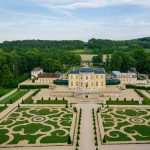The Future of Urban Real Estate Development: Transforming Cities Through Innovation
Urban real estate development stands at a pivotal moment where innovative technologies and sustainable practices are reshaping entire cityscapes. According to McKinsey’s 2024 Global Real Estate Report, smart building technologies have increased property values by an average of 12% while reducing operational costs by 30%. As cities worldwide grapple with housing shortages and environmental challenges, how can developers balance profitability with community impact? The answer lies in embracing comprehensive approaches that many World’s Richest Entrepreneurs are already implementing across their urban development portfolios.
Technology-Driven Solutions Reshaping Urban Landscapes
L’intelligence artificielle révolutionne aujourd’hui la façon dont les développeurs immobiliers conçoivent et optimisent les espaces urbains. Les algorithmes de machine learning analysent désormais des milliers de données en temps réel pour prédire les flux de circulation, identifier les zones à fort potentiel et optimiser l’utilisation de chaque mètre carré disponible.
Also to read : Empower your leadership through the mastered coaching program
L’Internet des objets transforme également l’approche de la planification urbaine. Les capteurs intelligents installés dans les bâtiments collectent des informations précieuses sur l’occupation des espaces, la consommation énergétique et les habitudes des utilisateurs. Ces données comportementales permettent aux planificateurs d’ajuster leurs projets en fonction des besoins réels de la communauté.
La réalité augmentée offre une nouvelle dimension à la présentation des projets urbains. Les développeurs peuvent désormais faire visiter virtuellement des espaces avant même leur construction, permettant aux parties prenantes de visualiser l’impact réel des aménagements sur l’environnement existant et d’apporter des modifications en temps réel.
Also to read : Enhance your home’s comfort with double glazing in haywards heath
Sustainable Development Strategies for Modern Cities
Modern urban development stands at a critical crossroads where environmental responsibility meets economic viability. Cities worldwide are embracing green construction practices that prioritize both ecological preservation and long-term profitability. These approaches represent more than environmental compliance—they define the future of urban living.
Energy-efficient building systems now form the backbone of sustainable urban projects. Advanced technologies like smart grid integration, passive solar design, and high-performance insulation reduce operational costs by up to 40% while minimizing carbon footprints. Copenhagen’s district heating system exemplifies this approach, serving 98% of buildings through renewable energy sources and waste heat recovery.
Urban biodiversity initiatives are reshaping city landscapes through innovative green infrastructure. Living walls, rooftop gardens, and integrated park systems create ecological corridors that support wildlife while improving air quality and reducing urban heat islands. Singapore’s “City in a Garden” vision demonstrates how biophilic design can enhance property values while delivering measurable environmental benefits.
Circular economy principles are transforming construction waste management and material sourcing. Forward-thinking developers now prioritize modular construction, recycled materials, and adaptive reuse strategies that minimize environmental impact while creating distinctive urban spaces that respond to evolving community needs.
Essential Components of Successful Urban Projects
Creating transformative urban developments requires a strategic approach that balances innovation with community needs. Successful projects emerge from careful planning, stakeholder alignment, and deep understanding of local dynamics.
The foundation of any successful urban project lies in these critical components:
- Strategic site selection – Analyzing demographic trends, transportation networks, and growth potential to identify optimal locations for maximum impact
- Community integration – Engaging local residents early in planning phases to ensure developments enhance rather than displace existing neighborhoods
- Diversified financing – Combining traditional funding with innovative instruments like green bonds and impact investments to reduce project risk
- Public-private partnerships – Leveraging government resources and private sector efficiency to accelerate development timelines and share costs
- Regulatory navigation – Understanding zoning laws, environmental requirements, and permitting processes to avoid costly delays
- Technology integration – Incorporating smart infrastructure and sustainable systems from the design phase to future-proof developments
These elements work synergistically to create urban projects that deliver lasting value for investors, residents, and the broader community while setting new standards for sustainable development.
Community-Centered Approaches in Modern Development
Successful urban development today requires a delicate equilibrium between profit margins and community welfare. Modern developers must navigate the complex landscape of stakeholder expectations while maintaining financial viability in their projects.
Meaningful citizen participation begins during the planning phase, not after construction starts. Forward-thinking developers organize community workshops and focus groups to understand local needs before breaking ground. This approach prevents costly redesigns and builds trust with residents who will ultimately shape the project’s long-term success.
Affordable housing integration presents both challenges and opportunities in mixed-income developments. Rather than segregating affordable units, innovative projects blend different housing types seamlessly throughout the development. This strategy creates diverse, economically sustainable neighborhoods while meeting municipal requirements and social responsibility goals.
Inclusive public spaces serve as the heart of community-centered developments. These areas must accommodate various age groups, cultural activities, and accessibility needs. Smart design incorporates flexible spaces that can host farmers’ markets, community meetings, or cultural events, maximizing utility while fostering social connections that define thriving neighborhoods.
Overcoming Contemporary Challenges in Urban Planning
Urban planners in 2025 face an unprecedented convergence of challenges that demand innovative solutions and adaptive strategies. The rapid pace of urbanization, combined with climate pressures and resource constraints, has fundamentally transformed how cities approach development and growth.
Densification emerges as both a necessity and a complex puzzle. Cities must accommodate growing populations while preserving livability and community character. Forward-thinking developers are responding with vertical neighborhoods that integrate residential, commercial, and green spaces within compact footprints. These mixed-use developments create self-contained ecosystems that reduce transportation needs while fostering vibrant urban communities.
Climate adaptation has moved from consideration to imperative. Rising temperatures, extreme weather events, and flooding risks require planners to reimagine infrastructure fundamentally. Smart cities now incorporate resilient design principles from the ground up, featuring permeable surfaces, urban forests, and buildings designed to withstand environmental stresses while minimizing energy consumption.
Financing constraints and regulatory complexity demand creative partnerships between public and private sectors. Successful projects increasingly rely on innovative funding models that align community benefits with commercial viability, transforming challenges into opportunities for sustainable urban transformation.
Market Trends and Investment Opportunities Ahead
The real estate landscape is experiencing a fundamental shift toward adaptive spaces that can evolve with changing needs. Mixed-use developments are becoming the cornerstone of modern urban planning, combining residential, commercial, and recreational elements within single projects. These integrated environments respond to the growing demand for walkable neighborhoods where people can live, work, and socialize without lengthy commutes.
The transformation of traditional office spaces presents compelling investment opportunities. As hybrid work models become permanent fixtures, developers are reimagining commercial properties into flexible environments that serve multiple functions throughout the day. Co-working spaces, event venues, and community hubs are emerging within former corporate towers, creating revenue diversification that appeals to forward-thinking investors.
Urban mobility infrastructure is driving significant value creation in previously overlooked areas. Transit-oriented developments near electric vehicle charging stations, bike-sharing hubs, and public transportation nodes are commanding premium prices. Smart city technologies integrated into these projects enhance operational efficiency while attracting tech-savvy tenants and buyers who prioritize connectivity and sustainability in their real estate decisions.
Questions fréquentes sur l’avenir du développement urbain
Le secteur immobilier évolue rapidement face aux défis urbains contemporains. Ces questions reflètent les préoccupations majeures des professionnels et investisseurs qui façonnent nos villes de demain.
What are the latest trends in urban real estate development?
Les quartiers mixtes dominent, intégrant résidentiel, commercial et espaces verts. L’accent porte sur la densification intelligente et les infrastructures partagées pour optimiser l’utilisation de l’espace urbain limité.
How is technology changing the way we develop real estate properties?
L’IA optimise la planification urbaine, les jumeaux numériques permettent des simulations précises, et l’IoT transforme la gestion des bâtiments. Ces technologies réduisent les coûts et améliorent l’efficacité énergétique.
What makes a real estate development project sustainable and profitable?
L’équilibre entre rentabilité économique et impact environnemental. Les certifications vertes, l’efficacité énergétique et l’intégration communautaire garantissent une valorisation à long terme des investissements immobiliers.
How do developers balance community needs with commercial real estate projects?
La consultation citoyenne dès la conception, l’intégration d’espaces publics et de services locaux. Cette approche collaborative crée une valeur partagée entre rentabilité et acceptation sociale.
What are the biggest challenges facing real estate developers in 2024?
L’augmentation des coûts de construction, les nouvelles réglementations environnementales et la pénurie foncière urbaine. Les développeurs doivent innover pour maintenir leur compétitivité dans ce contexte contraint.











